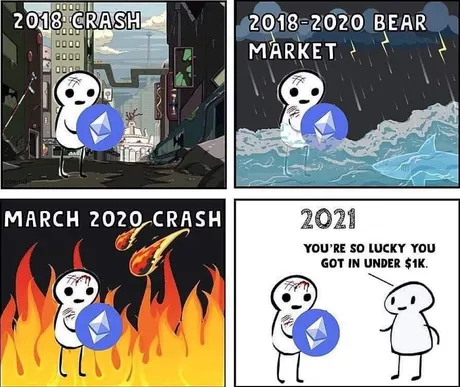
Two days ago I opened a short on Bitcoin at $55750.
Hm yeah, it hasn't played out so well. I logged into Binance today and see that I'm down $272. However, If I'm being honest, I was preparing myself for something more like a $500 loss. How did I get it so wrong?
It was only a few weeks ago that I went long on Bitcoin and was up like $500. That was with borrowing less money and taking less risk. How is it that I only lost about half as much on a short even as Bitcoin continues to knock on $60k's door?
I realized in that moment that shorting an asset is far less risky than going long. No wonder why it is such a popular tool with the powers that shouldn't be to control derivatives markets! Wow!
Looking at the math...
This all happens because USD is our unit-of-account. We measure all of our gains and losses in terms of a "stable" USD value. When I hold Bitcoin and the price goes up, I make money (obviously). But when I hold USD and the price of Bitcoin goes up, I've lost nothing. This is why it's safer to short an asset than go long.

Further explanation
Going long or short requires one to take out a loan. When I go long, I use my Bitcoin as collateral to take out a USD loan and buy more Bitcoin. When the price of Bitcoin goes up, both my collateral and loan increase in value. When the price goes down, both lose value.
However, when I go short, I use USD collateral and take out a Bitcoin loan. When the price goes up, only my loan is technically losing value. My collateral remains stable in USD form; worth the same amount that it was before. This is why I was able to do a much more aggressive short and still lose less money than when I was going long.
Unit-of-Account
All of these concept hinge on the dependence that USD holds a stable value and we can measure with it. If USD was not stable we'd have no idea how much value was gained or lost because the value of both assets would be in flux. There would have to be some mysterious third asset more stable than USD that we could use to measure what happened. This "mysterious" third asset is USD 99% of the time when we are trying to measure two volatile cryptos against each other. (Example: BTC/ETH)

BTC/ETH
That's another cool thing we can do with platforms like Binance. Rather than go short on USD or long on Bitcoin, we could go short on Bitcoin and long on Ethereum. Say we believe that Ethereum is going to flip Bitcoin, we could borrow Bitcoin using ETH collateral and dump the Bitcoin for Eth. Now we owe BTC and have a lot of ETH, effectively shorting BTC and longing ETH.
During the bear market we could do the opposite, knowing that BTC will retain its value better than the competition. Because we owe back a volatile crypto that is underperforming USD, it's an even better trade than borrowing USD because we'll owe back less (in theory if everything works out).
For Example, if Hive went x100 and we were like oh shit here comes that brutal crypto winter, we could theoretically borrow Hive, dump it on the market, and hope it crashes into the dirt over the next year. If it did... then we'd owe back hardly any money after everything was said and done.

If Bitcoin breaks this $60k unit-bias level I'm going to take the loss and close my short. Lesson learned: never short Bitcoin during the mega-bubble year. We have an entire year of 2022 to short the market. No need to get greedy just yet.
Posted Using LeoFinance Beta
Return from The Long and Short of it. to edicted's Web3 Blog
